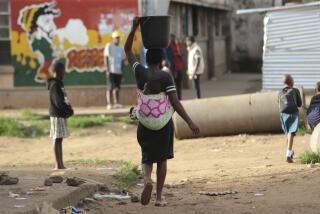A global clean-water shortage
- Share via
JOHANNESBURG, SOUTH AFRICA — While people in wealthy suburbs of Africa use water to maintain lush lawns and fill swimming pools, many slum dwellers struggle to obtain the crucial resource and pay much more per gallon for what little of it they can get, according to a United Nations Development Program report calling for an end to “water apartheid.”
At the same time, dirty water is the second-leading cause of death among children globally, after respiratory infections. It kills 1.8 million children younger than 5 each year, more than do HIV/AIDS, malaria, war or traffic accidents, says the U.N. report released Thursday in Cape Town.
“In the year 2015 they plan to send a spaceship to Jupiter to search for water, yet in Africa or India we can’t get water to people who need it,” Kevin Watkins, the report’s author, said at a briefing for media in Johannesburg. The session was held Tuesday, though release of the report was embargoed until Thursday.
The report’s main contention is that if countries increase access to clean water and sanitation simultaneously, the rates of child survival in developing countries can rocket “almost overnight,” Watkins said.
Globally, 2.6 billion people have no access to proper sanitation. The 1.1 billion people who don’t have clean water use about 1.3 gallons a day, compared with the 40 gallons used by average Americans, the planet’s biggest water guzzlers.
“It is hard to find anything that has a greater impact on human life than water,” Watkins said.
In Peru, offspring in families with toilets and clean water are 59% more likely to survive childhood than those without, according to the report. In Egypt, the figure is 57%.
In cities such as Dar es Salaam, capital of Tanzania, people pay more for water than do New Yorkers, Watkins said.
Many of those developing countries that are boosting access to water are not increasing the number of toilets or improving drainage systems, he said, risking the spread of disease.
The water and sanitation crisis in sub-Saharan Africa slowed economic growth by 5% of gross domestic product per year, more than the region receives in foreign aid, the report says.
A big increase in spending on water and sanitation would pay for itself in economic growth.
“No other investment could bring greater benefits,” Watkins said.
Collecting water is a colossal waste of labor, he said, with the burden falling overwhelmingly on women and girls. Sub-Saharan African women spend about 40 billion hours a year walking and queuing to collect water, equivalent to a year’s labor for the entire workforce in France.
The report calls for a global action plan led by the Group of 8 leading industrialized nations, which includes the United States, to increase the focus on water and sanitation.
It recommends that each developing country earmark at least 1% of its GDP to sanitation and sewage, more than twice the 0.4% currently spent by Kenya.
Some countries spend much more on their military than on water.
In Pakistan, where diarrhea caused by dirty water kills 118,000 people each year, the government spends 0.1% of its budget on water and sanitation. It spends 47 times that on the military.
India, where 450,000 die of diarrhea annually, spends eight times more on its military than on water resources, and Ethiopia, which has one of the highest rates of infant mortality due to lack of clean water and sanitation, spends 10 times more on the military.
Watkins said many developing countries failed to accord water and sanitation the central role necessary to save lives, improve standards of living and boost the economy.
Clear water-management plans would become more pressing with increases in global warming, particularly in sub-Saharan Africa, Watkins said.
More to Read
Sign up for Essential California
The most important California stories and recommendations in your inbox every morning.
You may occasionally receive promotional content from the Los Angeles Times.













